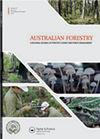Habitat value of, and social attitudes towards, dead trees in Canberra’s urban forest
IF 1.2
4区 农林科学
Q3 FORESTRY
引用次数: 3
Abstract
ABSTRACT Dead trees can occur throughout an urban forest and need to be managed. Standing dead trees that have been made ‘safe’ through regular inspection and the removal of unstable and decaying material are called ‘totem trees’ by Transport Canberra and City Services in Canberra, Australia. This paper is a pilot case study of totem trees in Canberra, employing an innovative mixed-methods approach, which includes silvicultural assessment, focal sampling, ad libitum sampling, in situ observation of evidence for fauna presence, and public questionnaires. It demonstrates that totem trees have significant habitat value because they provide perching, nesting, vocalisation, habitation and feeding sites for birds and arboreal mammals, as well as habitation and food for reptiles, insects and fungi. Totem trees with greater structural complexity appear to be preferred by fauna. The questionnaire findings, from park users and nearby park residents, indicate a generally positive attitude towards totem trees, with most participants perceiving them as valuable habitat for fauna and appreciating their aesthetic appeal. This highlights an important juxtaposition of management priorities: the need to balance structural complexity with providing safe trees. The findings of this study underscore the need to maintain and enlarge the totem tree population given their significant habitat value and social functions. Freestanding, structurally complex dead trees with numerous hollows, branches and bark should be prioritised for conservation. Additionally, the raising of public awareness is recommended to address any ongoing public uncertainty regarding the safety of totem trees.堪培拉城市森林中死树的栖息地价值和社会态度
摘要城市森林中可能会出现枯树,需要对其进行管理。通过定期检查和清除不稳定和腐烂的材料而变得“安全”的直立枯树被澳大利亚堪培拉交通局和城市服务局称为“图腾树”。本文是堪培拉图腾树的试点案例研究,采用了一种创新的混合方法,包括造林评估、焦点抽样、随意抽样、动物存在证据的现场观察和公共问卷调查。这表明图腾树具有重要的栖息地价值,因为它们为鸟类和树栖哺乳动物提供栖息、筑巢、发声、栖息和觅食场所,也为爬行动物、昆虫和真菌提供栖息和食物。结构更复杂的图腾树似乎更受动物的青睐。来自公园使用者和附近公园居民的问卷调查结果表明,人们对图腾树普遍持积极态度,大多数参与者认为图腾树是动物的宝贵栖息地,并欣赏其美学吸引力。这突出了管理优先事项的重要并置:需要平衡结构复杂性和提供安全树木。这项研究的发现强调了保持和扩大图腾树种群的必要性,因为图腾树具有重要的栖息地价值和社会功能。应优先保护具有大量凹陷、树枝和树皮的独立、结构复杂的枯树。此外,建议提高公众意识,以解决公众对图腾树安全的任何持续不确定性。
本文章由计算机程序翻译,如有差异,请以英文原文为准。
求助全文
约1分钟内获得全文
求助全文
来源期刊

Australian Forestry
FORESTRY-
CiteScore
3.70
自引率
4.80%
发文量
15
审稿时长
>12 weeks
期刊介绍:
Australian Forestry is published by Taylor & Francis for the Institute of Foresters of Australia (IFA) for scientific, technical, and professional communication relating to forestry in the Asia Pacific.
 求助内容:
求助内容: 应助结果提醒方式:
应助结果提醒方式:


